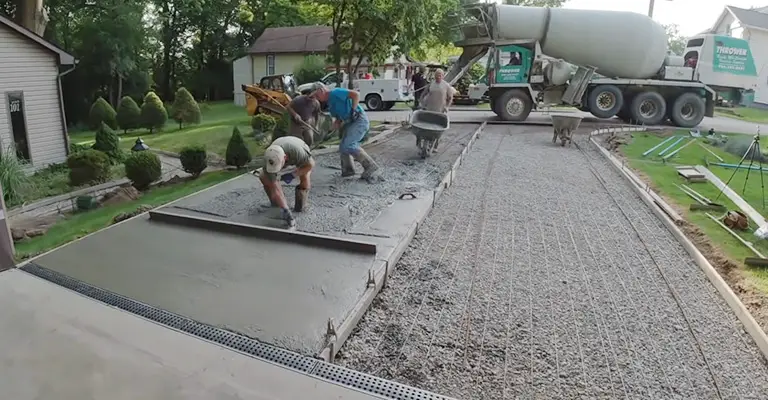You can definitely pour concrete over gravel for your next project! But there’s a crucial step before you get pouring. The key is to have a solid foundation for your concrete. Here’s why:
- Compacted gravel: Imagine a wobbly table – that’s what can happen to your concrete if the gravel underneath isn’t compacted properly. Compacting uses a special tool to press the gravel particles together, creating a firm base that won’t move. This helps prevent cracks in your finished concrete.
- Sand or crushed stone layer: Think of this as a stabilizing layer between the compacted gravel and your concrete. It fills in any gaps between the gravel pieces and creates an even surface for the concrete to rest on. By adding this layer, you’re giving your concrete the best possible start.
Pouring Concrete Over Gravel
The concrete would work its way into the gravel, so in most cases, that would make the concrete pad a little thicker since the concrete would spread a little into the gravel.
You’ll find 40–50% air in loose gravel. Pinning concrete on top will push the gravel into the supporting dirt, so you can expect more settlement. It’s best to compact it first.
Always play it safe when it comes to such matters. You just need to hire a compactor and compact the gravel. Be proud of doing things right; no shortcuts. Here’s what concrete slabs have in common:
1. Proper Drainage
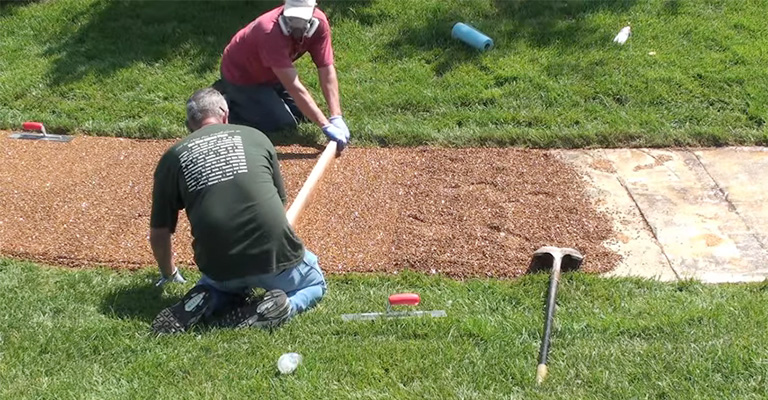
Put the slab on a slight pitch so the water drains. For 10′ of the runs, 1/2″ to 1″ of waterproofing should be enough.
2. Proper Compaction
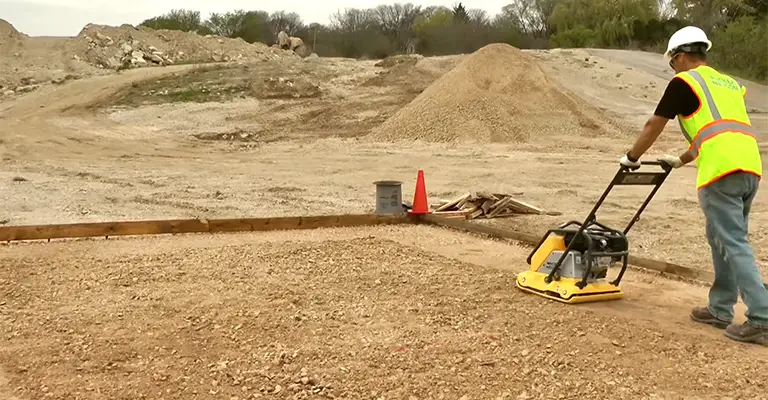
Check that the material under the slab is compacted. You need to compact the additional sand or gravel before placing the concrete if it’s for better drainage or levelling the area.
You can compact sand or road gravel better than loose stone. It would be great if gravel was undisturbed with a layer of compacted sand for more drainage.
Since topsoil compresses, it makes a lousy base, so it’s removed and replaced with gravel or sand. Because your base isn’t topsoil, and it’s been compacted by cars and settled for years, that won’t be a problem.
Can Gravel Be Used For A Foundation?
If you layer concrete, you’ll get a firmer foundation if you put as much gravel under the concrete as possible. So, you can target a four to six-inch gravel thickness.
Alternatively, lay a four-inch concrete slab over a three-inch gravel base. A gravel foundation helps absorb water and drain it, so your most prized structure stays dry from outpours and splashes.
In cases where you want a floor or patio, compressed gravel underneath can make it more stable, preventing cracks and shifting.
Factors To Consider When Pouring Concrete Over Gravel
Different building tasks require different combinations of concrete. Generally, concrete is acceptable over gravel, especially in clay soils with a lot of moisture.
It still depends on these things if you’re going to lay concrete over gravel:
Types of Gravel to Choose From
Gravel comes in all kinds of shapes and sizes, but here are four common types and their descriptions, applications, and advantages:
1. Crushed Stone
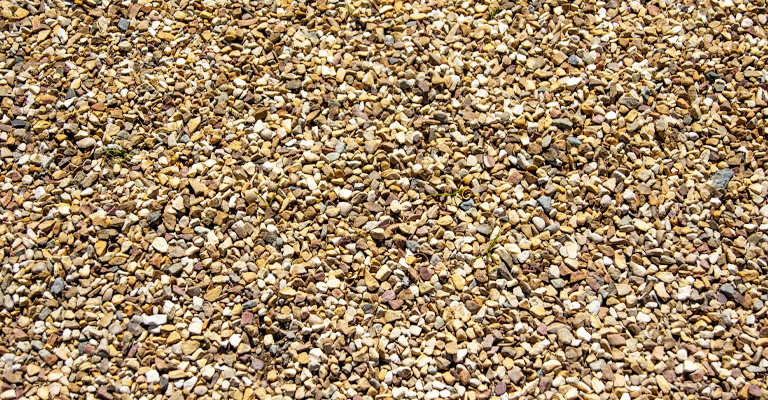
In general construction, this gravel must be the best material to be used under concrete since these angular rocks are used a lot in roadwork like railroad assembly and tarmac maintenance.
Various kinds of crushed stones, including trap rock, granite, dolomite, and limestone, can be used.
2. White Marble Chips
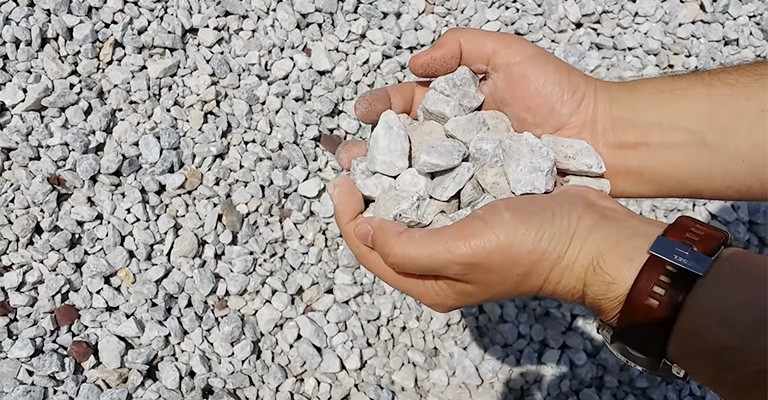
These stones stand out, most commonly used on paths and driveways because of their unique color (off-white with grey lines).
There’s a wide variety of names and styles (white marble stone pebbles, white limestone, white 34″ stone, etc.). These rocks are perfect for hilly terrain or sprucing up your lawn. They’ll keep soil in place and prevent weeds.
3. Washed Clean Stones
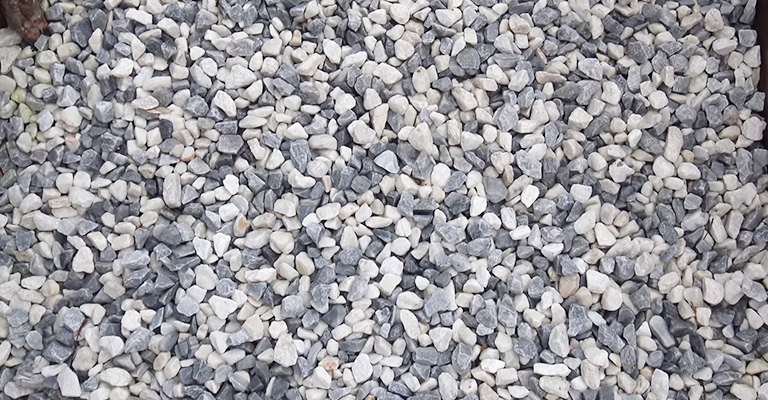
This distinction also applies to pea gravel. It’s washed, clean stones with a great luster, so it’s great for ornamental purposes. This type of gravel is the favorite of builders and consumers for its great drainage, low maintenance, and easy maintenance.
4. Pea Gravel
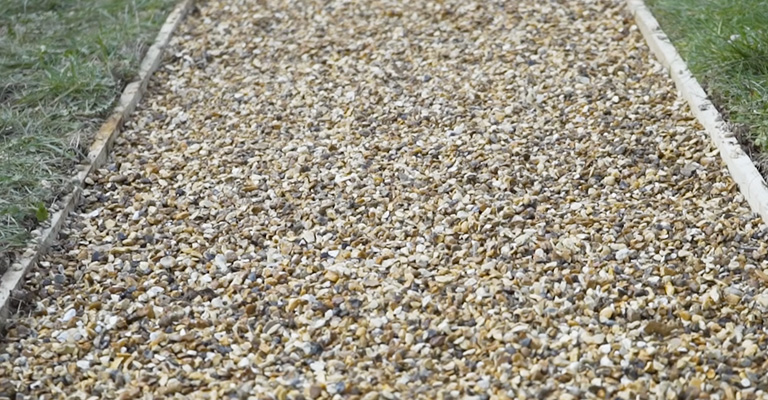
Among gravel categories, screened gravel is the most popular. Pea gravel fits the bill. The pea-sized pebbles are round and round.
This weed controller is easy to maintain, so it’s great for gardens and other landscaping projects since it’s kept in check two inches below the ground.
Right Size and Texture of Gravel to Use Under Concrete
The ideal size range for gravel stones is ¾ ” to 1″, although roughness may prevent this range from being ideal in certain situations.
The concrete will leak beyond one inch, making it hard to figure out how much concrete you’ll need.
There are two types of gravel texture: rough or fine. Harsh gravel measures no longer than 9.5mm, and fine gravel goes up to 38mm.
If you’re going to mix concrete and gravel, it’s better to choose gravel over 20mm thick.
Gravel is Useful Under Concrete Slabs
With all those spaces between, gravel can stop water from going up the concrete slab.
The ground flattens out faster, making it easier to measure the concrete needed since gravel can be compressed.
The soil erosion and cracking of concrete slabs can be prevented using dense gravel as an effective water drainage system.
Proper Base Preparation
A good gravel base is essential if you’re pouring concrete over gravel. The gravel should be well-compacted and evenly graded for the concrete surface to be stable and level.
It’s possible for concrete to crack, settle, and have uneven surfaces due to poorly prepared gravel bases.
Thickness
You’ll have to consider the concrete’s intended use and the load it will handle when it comes to gravel thickness.
Driveways, patios, and walkways can typically be constructed with a layer of compacted gravel around 4 to 6 inches (10 to 15 cm) thick.
Compaction
Compressing the gravel properly is essential to preventing settling and uneven concrete. You should use a mechanical compactor or similar tool to get the proper level of compaction.
Moisture Control
Make sure the gravel base drains well to avoid water accumulating under it. Concrete deteriorates, and erosion happens when there’s too much moisture.
Reinforcement
To make concrete strong and crack-resistant, you might consider adding reinforcement, like wire mesh or rebar, within the concrete.
Concrete Mix
Ensure the concrete mix you choose is strong enough for the project and doesn’t contain too many additives. To figure out what combination to use, talk to a concrete professional.
Expansion Joints
You need to install expansion joints in concrete at appropriate intervals to prevent cracking. These joints prevent cracks because the concrete expands and contracts with temperature changes.
Professional Advice
You should consult a concrete contractor or engineer if you’re uncertain how to pour concrete over gravel. If you want, they’ll assess your project and suggest best practices.
What Is The Thinnest Concrete That Can Be Poured?
Any structure’s foundation must be strong to stand the test of time. It usually ranges from four inches to six inches for your concrete base.
Be sure not to make it thinner than four inches if you want to be assured that you’re standing on solid ground.
How Thick Should A Concrete Base Be?
If you go as wide as 20 inches, you can get a concrete base that’s 4-6 inches thick. The first thing you need to think about is the budget. Also, make sure you know whether the structure will be a residential or business property.
Furthermore, you should check out your local building codes regarding the concrete slab’s thickness. Authorities have to follow regulations regarding the site’s geography where they’ll build the base.
How Do You Stabilize Gravel?
Stabilizing gravel would require gravel stabilizing grids to better secure gravel particles within its structure, providing a solid foundation. You can do this to give driveways, walkways, and parking lots a steady finish.
Final Words
A good foundation is made of concrete and gravel. Pour it over gravel, and you’ve got a rock-solid foundation. Keep these guidelines in mind, and your construction plan will be perfect.

